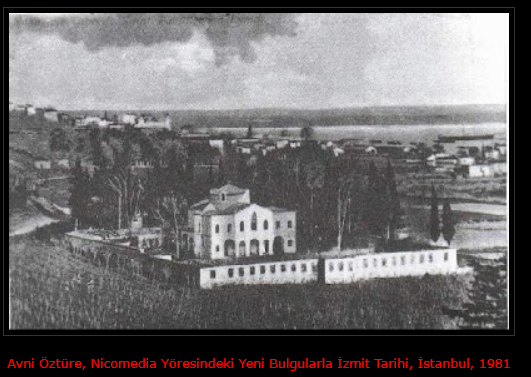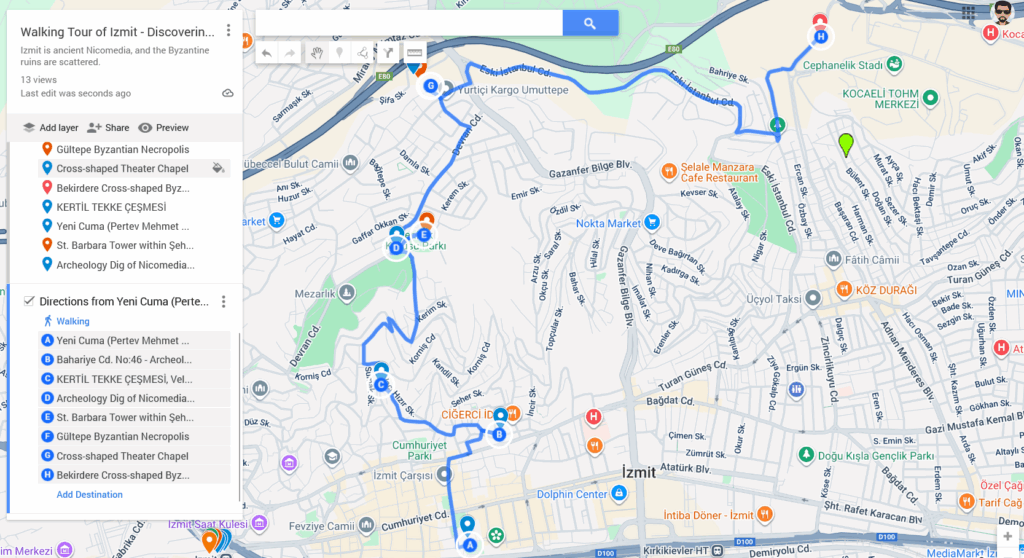The Byzantine churches spoke Greek and became a part of the Greek Orthodox Church in 1054 A.D. with the Great Schism. So, when we see Greek church buildings in Turkiye from the 18th and 19th centuries, we can assume that, in many places, there existed a Byzantine church at that location before or nearby. Let’s explore this possibility.
The Greek sources testify to four key churches in Izmit, with others that are possible. Let’s connect them to their location and what we know of them today.
The difficulty in discovering the former Greek churches in Izmit is that during World War I, the Kingdom of Greece controlled Izmit. So when the Turkish armies took over again, out of revenge, destruction took place. See my write-up about this in nearby Iznik.
Evidenced-based Greek Churches
In 1866, the Greek population in Nicomedia numbered 4,472 people, and approximately the same number of students attended Greek-language schools. The War of Independence in Greece created tension with the Ottoman Empire, which harmed Greek-speaking communities. Unfortunately, when religions take on nationalistic and political bents, this often forfeits the spiritual focus. In Galatians 3:28 it says, “There is neither Jew nor Greek, there is neither slave nor free, there is no male and female, for you are all one in Christ Jesus.” The boundaries and divisions we establish contradict the unity of Christ. As believers, we know that God loves all people and that he desires to implement this unity of Christ upon all peoples, regardless of nationality.
Ἅγιοι Ἀνάργυροι — Κοσμᾶς καὶ Δαμιανός — Agioi Anargyroi (Cosmas & Damian). In my previous write-up, I attest to the church’s presence in known history.[1]see also:Διακόνημαmountathos360.com However, today its location is unknown as to what part of the city it was located in.
Ἅγιος Παντελεήμων / Παντελεόν — St Panteleimon (Pantaleon) — This is a well-known monastery in church literature and locally in Nicomedia by oral history.[2]see: Greek Orthodox Archdiocese of Americaehw.gr Historical records indicate that this monastery and church were situated on the hillside above the shoreline. His tomb was located under the church till its destruction.[3]https://kocaeliansiklopedisi.com Although this was an ancient church, its name persisted in Greek sources up to the 20th century. One online site locates this monastery in the Yenidoğan Mahallesi neighborhood and provides a picture of the location, situated on a hillside overlooking the shore. PrevPreviouslyiously, this area may have been known as Adamantios in Greek.[4]See Sharon E. J. Gerstel “Tiles of Nicomedia’ and the Cult of Saint Panteleimon,” in Byzantine Religious Culture: Studies in Honor of Alice-Mary Talbot, ed. D. Sullivan, E. Fisher, and S. … Continue reading
Erkan Kiraz’s Insights
Erkan Kiraz says that Nurettin Pasha bombarded the location with cannon fire in 1923. Since St. Panteleimon was known for his medical and healing qualities, the Izmit Seka State Hospital (built in 1926) likely sits on or near this location.[5]This is where Avni Öztüre placed it in his book. Erkan Kiraz mentions that the placement of the D-100 highway on the location destroyed it in the 1950s. Additionally, Ottoman Sultans Mahmud II and his son Abdülmecid completed renovations during the 1830s, further solidifying the location’s Ottoman significance. Unfortunately, this has not helped the modern preservation of the site.

Erkan Kiraz’s site is worth a visit, and his information is so helpful in putting the pieces of the hidden puzzle of together about this ancient site in Izmit.[6]https://erkankiraz.blogspot.com/2008/12/aya-pandeleymon-hagios-pandeleimon-st.htmlA screenshot from his website shows the monastery. A retaining 5-meter wall of the site remains in modern-day Izmit near the locations mentioned.[7]https://kocaeliansiklopedisi.com[8]Also, Avni Öztüre, Nicomedia yöresindeki yeni bulgularla: İzmit tarihi, İstanbul 1981, p.178 provides more detail.
Other Greek Churches in Izmit
Ἅγιοι Ταξιάρχαι (Taxiarchai) — Archangels (Michael & Gabriel) — A church appears in Greek Nicomedia parish records, which is most likely a village area and not found in the city of Izmit.[9]Some suppose that this thesis gives the name of the church, but it is not listed in Η εκπαίδευση στη μητρόπολη Νικομηδείας Μ. Ασίας κατά τον 19ο … Continue reading
The Metropolis of Nicomedia established educational Greek-speaking schools in Asia Minor until 1922. With this process, churches were most likely located near the schools. However, the environment proved hostile to the churches, especially during World War I.
Ἅγιος Ἰωάννης ὁ Πρόδρομος — St John the Forerunner / Baptist – Some local Greek community inventories mention this church, but with limited knowledge about remains.[10]see: Ikeekms.org.gr So, it remains unknown where this church was located in the city. Also, names like Ἅγιος Νικόλαος — St Nicholas[11]kms.org.grIkee or Ἅγιος Νικήτας — St Nikitas.[12]kms.org.gr appear but without much information. In most of these documents, even some of the names do not exist online. I am still researching some of these, but place their names and others like Κοίμησις τῆς Θεοτόκου — Dormition / Assumption of the Theotokos and Ἀνάληψις — Ascension here for other researchers.
Imperial Basilica of Nicomedia
Ἁγία Βασίλισσα — Hagia Vasilissa is a church that connects to the former imperial palace and sat near the shoreline. If in the imperial palace, then this was the Byzantine basilica for the court and those who governed from ancient Nicomedia. Vasilissa (sometimes called Basilissa), martyred in 303, was a young queen who stood firm in her faith in Christ and was thrown into the fire, which she survived.[13]https://agiosgeorgiosparalimniou.org.cy/index.php/iera-paradosi/vioiagion/11437-agia-vasilissa-3-septemvriou
Her status as a queen and martyr justifies this imperial church. Additionally, we know that Helena, the mother of Constantine, funded numerous churches during her lifetime and passed away in Nicomedia. Could it be possible that she also financed this church to honor a woman of royal descent, like herself, in the city where she lived?
Today, the imperial palace is located, and the ruins are on display at the Kocaeli Archeology Museum; however, no written history has provided proof of this imperial basilica. However, the opus sectile marble tiles used in imperial buildings were also a technique used in many Byzantine basilicas.[14]see In-situ Conservation and Restoration of Opus Sectile Pavement of Çukurbağ (İzmit-Nikomedia) Archaeological Site (2022) By Serkan GEDÜK – this writer places images of the marble in the … Continue reading
Searching through the ruins of Izmit may uncover more clues about its history. While the ancient city of Nicomedia is represented by its statues in the museum, we must also consider the stories of the people and their beliefs. This city was the site of the largest known persecution in Christian history, yet the memories of these martyrs continue to fade with time.

In my research of ancient sites, I attempt to make observations by connecting what I see with my other visits elsewhere. If my observations are incorrect, please share your insights. Also, if you discover something new, please let me know. I am always willing to correct any errors in my writing.
References
| ↑1 | see also:Διακόνημαmountathos360.com |
|---|---|
| ↑2 | see: Greek Orthodox Archdiocese of Americaehw.gr |
| ↑3, ↑7 | https://kocaeliansiklopedisi.com |
| ↑4 | See Sharon E. J. Gerstel “Tiles of Nicomedia’ and the Cult of Saint Panteleimon,” in Byzantine Religious Culture: Studies in Honor of Alice-Mary Talbot, ed. D. Sullivan, E. Fisher, and S. Papaioannou (Brussels, 2011), 178. |
| ↑5 | This is where Avni Öztüre placed it in his book. |
| ↑6 | https://erkankiraz.blogspot.com/2008/12/aya-pandeleymon-hagios-pandeleimon-st.html |
| ↑8 | Also, Avni Öztüre, Nicomedia yöresindeki yeni bulgularla: İzmit tarihi, İstanbul 1981, p.178 provides more detail. |
| ↑9 | Some suppose that this thesis gives the name of the church, but it is not listed in Η εκπαίδευση στη μητρόπολη Νικομηδείας Μ. Ασίας κατά τον 19ο αιώνα έως το 1922 – this is a thesis about education and not churches in Izmit. |
| ↑10 | see: Ikeekms.org.gr |
| ↑11 | kms.org.grIkee |
| ↑12 | kms.org.gr |
| ↑13 | https://agiosgeorgiosparalimniou.org.cy/index.php/iera-paradosi/vioiagion/11437-agia-vasilissa-3-septemvriou |
| ↑14 | see In-situ Conservation and Restoration of Opus Sectile Pavement of Çukurbağ (İzmit-Nikomedia) Archaeological Site (2022) By Serkan GEDÜK – this writer places images of the marble in the write-up. None of the marble tiles exhibits cross-like features, which I have observed in churches of that time period. |
Leave a Reply